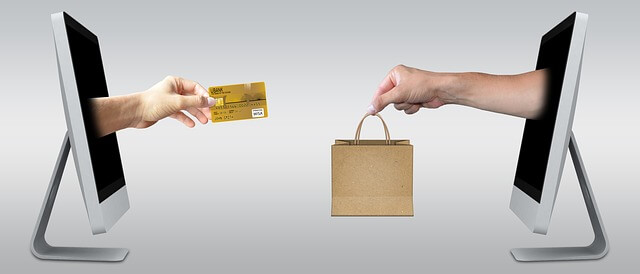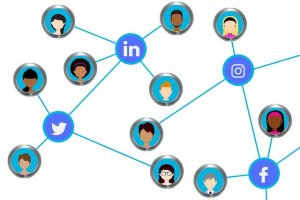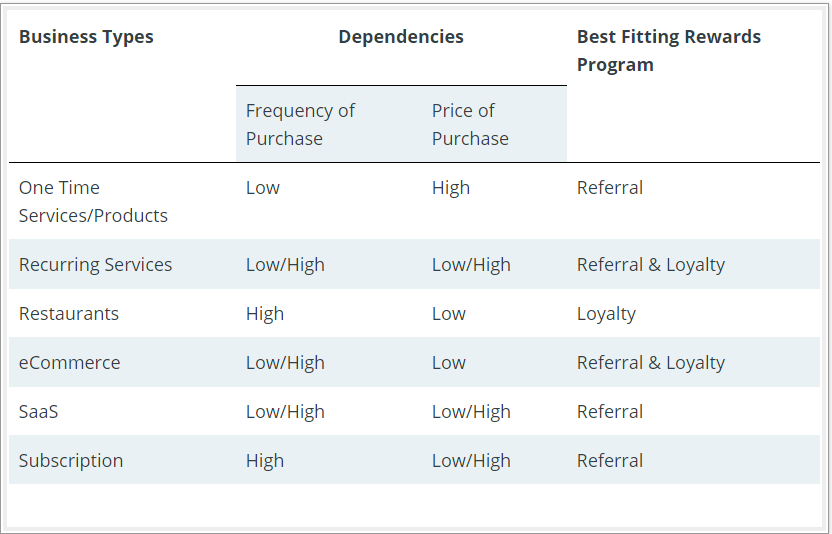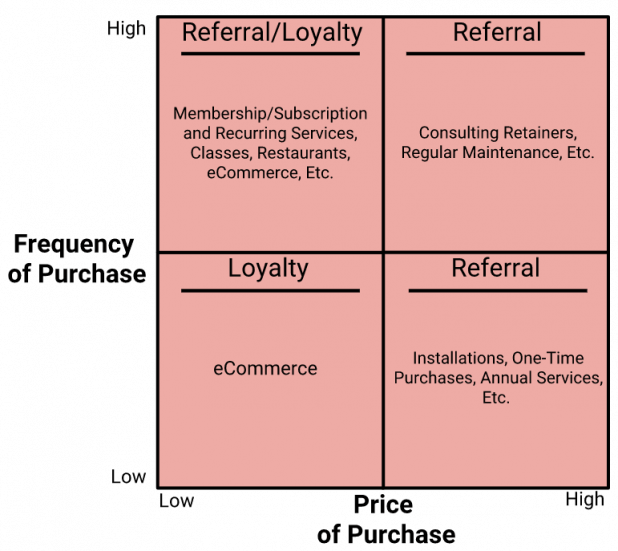Let’s clear some things up. A loyalty program and a referral program are two different things. Yes, there are some similar aspects—for example, rewards. Both types of programs can easily be considered reward programs. There are, however, many differences between the two. Let’s cover the similarities and differences between referral programs and loyalty programs.
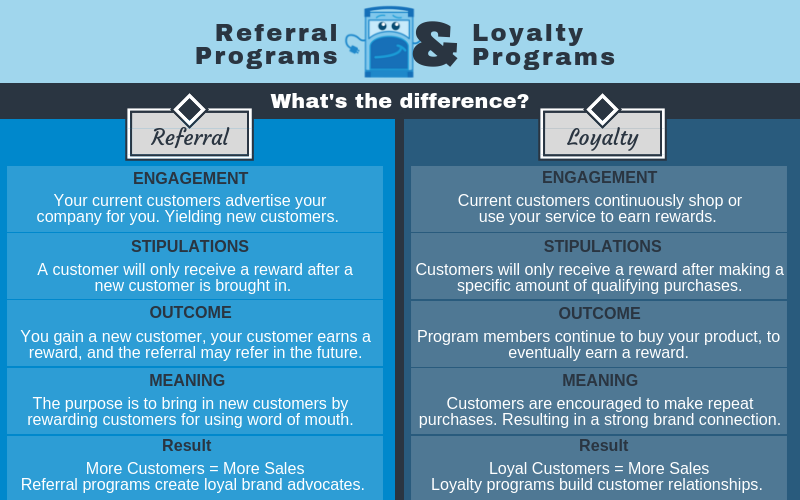
Referral Programs And Loyalty Programs: Similarities
Referral programs and loyalty programs can go hand in hand. This may be why people often confuse the two for being the same thing. There are elements of each type of program that can easily be intertwined. Consider a customer that has made multiple referrals—they can easily be considered a loyal customer. Also, consider that some referral programs require customers to refer many people before receiving a reward. That’s pretty similar to a loyalty program, isn’t it?
Rewards programs are great for both retaining loyal customers and driving new customers to your business. The classic customer programs divide into two major types. Loyalty and referral, which use their own type of rewards program software.
With both of these types of programs, the goal is to drive more customers. Whether that means drive existing customers to return or expand your customer base altogether. Rewards programs also tend to produce pretty quality customers, who end up spending more in the long run.
Referral Programs Vs. Loyalty Programs: Differences
There is a fine line between referral and loyalty programs, however. In some cases, you may see a business run both types of programs simultaneously because both referral and rewards program software work. If a business can run both at the same time, then, obviously they are two separate things.
Okay, so you are probably wondering what makes referral programs different from loyalty programs. Here are some criteria to help you understand the differences between the two.
Purpose Differences Between Loyalty and Referral Programs
Even though elements from each seem to be intertwined, the foundations of these rewards programs are quite different. For example, a customer who sent their referral code multiple times can be considered a loyal customer, but it does not mean they are in a loyalty program. Both types of programs, however, do lead to better customers and more sales.
Purpose of Loyalty Programs
Loyalty programs drive repeat sales from your existing customers
- Rewards person for their repeat actions
- Typically utilizes punch cards, point systems, rewards cards
- Rewards are only received after some many qualifying behaviors are complete
Think of a coffee shop that offers customers a stamp card. A customer is driven to buy coffee at that particular coffee shop time and time again, because after a few visits, they will be rewarded with a free coffee.
Purpose of Referral Programs
Referral programs drive sales from new customers and encourage repeat customers.
- Utilize existing customers to refer their friends (word of mouth)
- Rewards can be issued to both referring customer and new customer
- Rewards are typically earned when a sale is made. (pay per performance of a sale not just for leads)
- Rewards can be staged for a specific qualifying event or series of events based on your sales process. (i.e. when a qualifying demo occurs, a certain purchase amount is made… etc.)
- This results in an expanding customer base using your existing happy customers to drive new business and only paying for it when a new sale is made.
- An added bonus happens by rewarding your customers for the friends they refer, as it increases their loyalty to your business.
- There are many types of referral rewards out there, such as discounts, free products, store credits, and gift cards. The trick is picking something that best fits your type of business.
When to Use Referral Programs vs. Loyalty Programs
Because of the foundational differences, the timing of when best to use referral and loyalty programs differs as well.
When to use a loyalty program
It’s probably easiest to use a customer loyalty program for items that don’t necessarily cost a ton of money. This is because the customer is required to make more purchases before being rewarded. A simple way to track a loyalty program is to provide the program members with a frequent purchase card or set up a system that can track the customer’s purchases or use loyalty software.
Typically, loyalty rewards program members don’t need to be reminded of the program because your product or service is something that they buy daily or weekly (or at least a few times a month). For example, a coffee shop may have a loyalty card where you buy 5 and get your 6th cup free. Your product or service is something that they already plan on buying and they keep coming back to you because it will eventually pay off for them.
When to use a referral program
A sure-fire way to increase word-of-mouth surrounding your business is to use a referral program, where a loyal existing customer encourages their friends to become your new customers. Referral programs can be a strategic way to have a constant flow of new customers coming in.
- Aside from growing your pool of customers, referral programs also keep the program member a loyal customer by usually offering incentives for spreading the word.
One of the easiest ways to run a referral program is by using some form of referral software which is a bit different than loyalty program software.
- This works well because referral software can seamlessly fit into your business, and that’s just one reason to love a referral program.
- A referral software program provides an easy way of sharing your company in ways convenient for the program member—via email, via social media, or by copying and pasting a referral code or link.
- Plus, thanks to tracking, it allows you and the member to know how many new customers are brought in.
Why Loyalty Programs Work
It’s no secret that VIP customers feel, well… very important. They feel like they belong to an exclusive group, that surpasses and is clearly separate from the other customers.
So you ask…Do loyalty rewards programs actually work? Well, they lead to customer retention, so I’d say yes. To be more specific, customer retention indicates the length of which a customer will remain with your business. Most loyalty rewards programs help this rate increase over time because of the length of a customer’s loyalty increases.
Even if you just increase your retention rate a tiny bit, your profits will see a big increase.
- Bain & Company found that “increasing customer retention by 5% can lead to an increase in profits of 25% – 95%”.
- Plus, it can be easier to convert existing customers into repeat customers than it is to convert new leads.
Why a loyalty rewards program works
Essentially loyalty programs work because they promote the VIP feel. For example, think of Amazon Prime. You pay a monthly fee to get into the club. But, once you’re in, you have the opportunity to bypass certain obstacles. You get extra perks, along with other exclusive rewards. Because of these perks, the customer has a reason to come back and shop again. This VIP loyalty program also helps build trust within the brand. Most people who are Prime Members would rather just order their goods from the Amazon website. Some have even switched to start using other Amazon products like Amazon Pantry for grocery shopping and Amazon TV for watching movies and shows because it’s so convenient and comes as one of their perks. Amazon did well before they introduced Prime, but are now making an even bigger killing in the eCommerce world.
A real-world loyalty program example: Starbucks
Starbucks – The coffee of the world. How’d they get there? Some of it has to do with them getting into business at the right time. A bit has to do with them being located on every corner. Finally, a tiny bit of it is because of their loyalty program.
Their loyalty program did not lead to their success, but it has played a steady role in keeping customers loyal. Customers simply load money onto their Starbucks card, and then they can build up their rewards. Because there is money already on their card, they are more inclined to use it, meaning that customer is far more likely to choose Starbucks for their morning coffee run than another brand. With each purchase, they earn a few stars (reward points). Eventually, they trade those stars in for a free drink or food item. The cycle continues, on and on.
Why Referral Programs Work
Though loyalty programs seem like they are the best strategy out there, many marketers and businesses want more from their loyalty programs. This is where referral marketing comes into play.
As it turns out referral rewards programs tend to produce even better customers. According to research, referred customers are better for many reasons.
- One of the top reasons is that they have a higher lifetime value than non-referred customers.
- This can then point to the fact that referred customers churn less often.
- Referred customers tend to spend more over their lifetime as a customer as well.
- Finally, to put the cherry on top, referred customers are prone to referring more customers. Meaning more loyal sales and more new sales!
Obviously, that’s a lot of hype for a rewards program. But the data truly does back it up. As you can see… Referral rewards programs produce quality customers, who also happen to be very loyal.
Why a referral reward program works
Referral programs work because marketing is done by the customer instead of marketing to the customer. Customers essentially share your business with their friends and do all the convincing for. It relies heavily on word-of-mouth marketing and the desire to share.
Referral marketing takes half the battle out of your hands, as you don’t have to work as hard to find people in your target market. And, you don’t have to spend loads of money trying to advertise to them. This actually works considerably well, since people trust recommendations from people they know, more so than any other form of advertising. Thus, they’re more likely to become your customers after being referred by a friend.
A real-world referral program example: Dropbox
Dropbox is one of the biggest file sharing and storage services on the internet. But, how’d they get there? Well, not only is Dropbox a service that people want and need. It also implemented a referral program, which helped boost users exponentially. Now, we can’t assume the referral program takes all the cheese, but mixing it with a highly in-demand service definitely helped.
Dropbox started a program because they needed to. They simply didn’t want to spend a ton of money on ads or do a lot of research on search-terms. So, they launched a rewards program with a 2-sided incentive. The incentive wasn’t a traditional monetary reward either. They offered extra storage space which drove to an increase in signups by 60%! Over 2.8 million referral invites happened during their first 18 months of running the rewards program. To this day, referrals still count as a large portion of their overall signups.
Loyalty Vs. Referral: Which rewards program software will work best for my business?
Businesses operate differently, so certain rewards program software may make more sense than others to implement. By now you should realize that the foundation of each rewards program is different. Let’s see which type of program makes sense for each type of business.
One-Time Services – Think of installations, one-off purchases, annual services. A roofing company would fit into this category, for example. The customer spends a lot of money on one item or project in this case. Best option: Referral
Recurring Services – Classes, regular maintenance, consulting. A few good examples of a recurring service would be pest control, an art class, a personal trainer, a salon, or even a dentist. These types of services may happen annually, every month, or week. Obviously, there is a difference in price, depending on the service. But, generally speaking, these types of services are typically more affordable than a one-time service. Referral and Loyalty both work well
Restaurants – Fast-food, cafes, coffee shops, a food truck, etc. Any facility who serves food in exchange for compensation. Customers may frequent the same facility, and typically do not have to spend too much to make a purchase. Best option: Loyalty
eCommerce – The buying and selling of goods online. A well-known example would be Amazon. Other online stores are popping up frequently, all thanks to platforms like Shopify and Etsy. Though some could argue shopping online can be expensive, generally speaking, most eCommerce purchases are actually quite affordable and convenient. Meaning someone may make frequent small purchases from the same online shop. Referral and Loyalty both work well
SaaS – SaaS applications and web-based software are becoming increasingly popular. This is because they are cost-effective and provide for seamless integration for all business types. CRMS, cloud-based customer support, real-time online messaging, cloud storage, etc. are all examples of a SaaS type business. Most users pay a monthly, annual, or bi-annual fee. So the frequency and price are based on the service. So it could be a low-frequency, high purchase, or a high-frequency, low purchase, or really anything in between. Best option: Referral
Subscription – Subscription boxes are booming. It seems every nook and cranny in the market has them. A few include pet boxes, sock subscription boxes, children boxes, and even monthly makeup boxes. These typically have a frequent monthly purchase, and they tend to be affordable. Best option: Referral
Dependencies: Major factors in choosing referral vs. loyalty
The frequency of purchase – When considering what type of rewards program to implement, you should consider the frequency of which a customer will make purchases. Referral programs can work with both low and high-frequency purchases. Whereas loyalty programs seem to benefit more just high-frequency purchases (though can work with low frequency, depending on the type of business).
Size of purchase – The price of the purchase also plays a role in determining what type of rewards program you should implement. A loyalty program does not seem to work with high priced purchases since these types of purchases are not made frequently enough. Whereas a referral program works well with high priced purchases. Referral programs can also work well with low price purchases too – depending on the type of business.
How can a business run both referral and loyalty programs?
Some business types can use both a referral rewards program and/or loyalty program. It really depends on what the end goal is. It also depends on the specific business model.
For example, a recurring business, like pest control, can work for both referral and loyalty because, typically, there is a monthly fee for participating. Meaning, a loyalty program has enough opportunities to build up and eventually can produce a reward for the customer (i.e. pay for 6 months, get a month/item free). A referral program also makes sense in this case because even though the frequency is often and the price is generally low, a customer will see the benefit in referring. This is especially true when a reward is present (i.e send a referral, get a free month or a percentage off your next month). In some cases, a business will choose to run both types of programs, at the same time, in an effort to both increase sales and expand their customer base.
A real-world example: Gilt
Gilt – an eCommerce store that sells a little bit of everything, runs a membership rewards program. A customer can earn points for every dollar spent, just as they can earn points for every referral made. They then trade these points in for discounts, gift cards, and even free merchandise.
Why can’t some businesses run both referral and loyalty programs?
Other types of businesses may not fare well doing specific rewards programs. A one-time service type business, for example, won’t be a very great loyalty rewards program host. This is because, in order to earn rewards with a loyalty program, the customer must make pretty frequent purchases. So big purchases, like cars, furniture, roofs, remodeling, etc. simply won’t work as customers will not need to purchase these items often or again at all.
A referral program, in this instance, makes much more sense. As these types of customers will refer their friends who need the same service/product, especially if they had a good experience. Throw on an incentive and it’s even more enticing to refer someone. A car salesman, for example, may offer the new customer a discount off their new car, and they will probably send some sort of gift card to the referrer.
Rewards program software can be a lifesaver
There is no doubt you can set up one of these programs on your own. However, rewards program software makes life easier. Because for both of these types of programs, there is a lot of the behind the scenes work that goes into them.
Everything from measuring results, program sharing, to reward distribution can be handled. Not to mention technical support is handled, as well as software updates. Meaning the headache is no longer on the shoulders of your own IT department. Plus, rewards program software sure beats keeping up with spreadsheets!
Though these programs have some overlapping details, they are run by software that is detailed to each type. Some rewards program software will specialize in referral programs, while others are specific to loyalty programs.
Wrapping up
One of the most remarkable things about these types of programs is that they create value for the customers and the company. With both referral programs and loyalty rewards programs, you have the opportunity to create long-term relationships while you grow your business—relationships that encourage your existing customers to keep buying from you.

